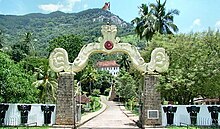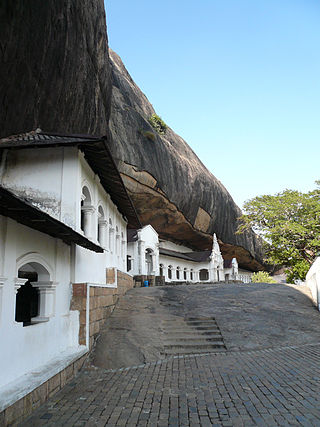
Dambulla is a town situated in the north of Matale District, in Sri Lanka's Central Province. It is the second largest populated and urbanised centre after Matale in the Matale District. It is situated 148 km (92 mi) north-east of Colombo, 43 km (27 mi) north of Matale and 72 km (45 mi) north of Kandy. Due to its location at a major junction, it is the centre of major vegetable distribution in the country.
Since the death of the historical Buddha, Siddhartha Gautama, Buddhist monastic communities ("sangha") have periodically convened to settle doctrinal and disciplinary disputes and to revise and correct the contents of the Buddhist canons. These gatherings are often termed Buddhist "councils". Accounts of these councils are recorded in Buddhist texts as having begun immediately following the death of the Buddha and have continued into the modern era. The earliest councils are regarded as real events by every Buddhist tradition. However, the historicity and details of these councils remains a matter of dispute in modern Buddhist studies. This is because various sources belonging to different Buddhist schools contain conflicting accounts of these events and the narratives often serve to bolster the authority and prestige of specific schools.
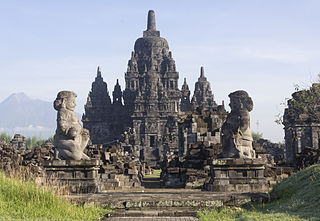
A Buddhist temple or Buddhist monastery is the place of worship for Buddhists, the followers of Buddhism. They include the structures called vihara, chaitya, stupa, wat and pagoda in different regions and languages. Temples in Buddhism represent the pure land or pure environment of a Buddha. Traditional Buddhist temples are designed to inspire inner and outer peace.

Mahāvaṃsa is the meticulously kept historical chronicle of Sri Lanka until the period of Mahasena of Anuradhapura. It was written in the style of an epic poem written in the Pali language. It relates the history of Sri Lanka from its legendary beginnings up to the reign of Mahasena of Anuradhapura covering the period between the arrival of Prince Vijaya from India in 543 BCE to his reign and later updated by different writers. It was first composed by a Buddhist monk named Mahanama at the Mahavihara temple in Anuradhapura in the 5th or 6th-century CE.
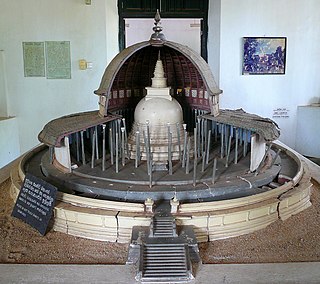
The Anuradhapura Maha Viharaya was an important mahavihara or large Buddhist monastery for Theravada Buddhism in Sri Lanka. King Devanampiya Tissa of Anuradhapura founded it in his capital city of Anuradhapura. Monks such as Buddhaghosa and Dhammapala, who wrote commentaries on the Tipitaka and texts such as the Visuddhimagga, which are central to Theravada Buddhist doctrine, established Theravada Mahaviharan orthodoxy here. Monks living at the Mahavihara were referred to as Mahaviharavasins.
Matale is a major city in Central Province, Sri Lanka. It is the administrative capital and largest urbanised city of Matale District. Matale is also the second largest urbanised and populated city in Central Province. It is located at the heart of the Central Highlands of the island and lies in a broad, green fertile valley at an elevation of 364 m (1,194 ft) above sea level. Surrounding the city are the Knuckles Mountain Range, the foothills were called Wiltshire by the British. They have also called this place as Matelle.

The Dīpavaṃsa is the oldest historical record of Sri Lanka. The chronicle is believed to be compiled from Atthakatha and other sources around the 3rd to 4th century CE. Together with the Mahāvaṃsa, it is the source of many accounts of the ancient history of Sri Lanka and India. Its importance resides not only as a source of history and legend but also as an important early work in Buddhist and Pali literature.
The ancient Sri Lankan people excelled in the construction of tanks (Wevas) or reservoirs, dagobas, and palaces in Sri Lanka, as evident from the ruins which displays a rich variety of architectural forms.
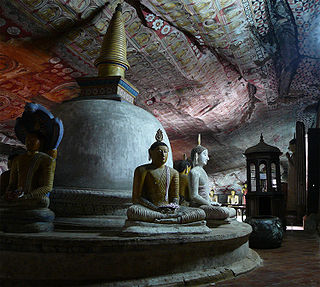
Dambulla cave temple, also known as the Golden Temple of Dambulla, is a World Heritage Site (1991) in Sri Lanka, situated in the central part of the country. This site is situated 148 kilometres (92 mi) east of Colombo, 72 kilometres (45 mi) north of Kandy and 43 kilometres (27 mi) north of Matale.
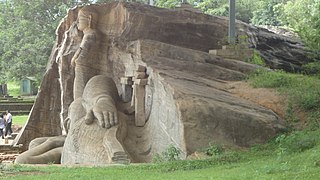
The Gal Vihara, and known originally as the Uttararama, is a rock temple of the Buddha situated in the ancient city Polonnaruwa, the capital of the ancient Kingdom of Polonnaruwa, now present-day Polonnaruwa, in North Central Province, Sri Lanka. It was fashioned in the 12th century by King Parakramabahu I. The central feature of the temple is four rock relief statues of the Buddha, which have been carved into the face of a large granite gneiss rock. The images consist of a large seated figure, another smaller seated figure inside an artificial cavern, a standing figure, and a reclining figure. These are considered to be some of the best examples of ancient Sinhalese sculpting and carving arts, and have made the Gal Vihara the most visited monument at Polonnaruwa.

Tipiṭaka or Tripiṭaka, meaning "Triple Basket", is the traditional term for ancient collections of Buddhist sacred scriptures. The Tripiṭaka is composed of three main categories of texts that collectively constitute the Buddhist canon: the Vinaya Piṭaka, the Sutta Piṭaka, and the Abhidhamma Piṭaka.

Ridi Viharaya or Silver Temple is a 2nd-century BCE Theravada Buddhist temple in the village of Ridigama, Sri Lanka. Built during the reign of Dutthagamani of Anuradhapura, the temple is considered as the place where the silver ore, which provided silver to complete Ruwanwelisaya; one of the largest stupa in Sri Lanka, was discovered. According to the chronicles Mahavamsa and Thupavamsa, the Ridi Viharaya complex was built in gratitude for helping him cherish his dream of completing Ruwanwelisaya.

Weliwita Asaranasarana Sri Saranankara Sangharaja Thero or popularly Weliwita Sri Saranankara Thero was a Buddhist monk, who was the last Sangharaja of Sri Lanka. He was the pioneer in the revival of Buddhism in Sri Lanka, after the decline of the religion in the 17th and 18th centuries. Saranankara Thero was bestowed with the a title by king Kirthi Sri Rajasinghe in 1753, the same year he received the Upasampada and re-established the Upasampada in Sri Lanka with the help of Mahasangha in Siam. He is also credited with the establishment of Silvath Samagama, a union of monks who lived in accordance with the Buddhist monastic discipline.

Gadaladenyia Vihara is an ancient Buddhist temple situated in Pilimathalawa, Kandy, Sri Lanka. It is located on Gadaladenyia Road (B116), just up from the Gadaladeniya junction of the Colombo - Kandy Road (A1), approximately 12.5 km (7.8 mi) to the west of Kandy and 3 km (1.9 mi) from the ancient buddhist temple, Lankatilaka Vihara. It is considered one of the largest rock temples in Sri Lanka.

Degaldoruwa Raja Maha Vihara is a Buddhist rock temple in Amunugama, Kandy, Sri Lanka. It is famous for its Kandyan Era Frescoes. The cave itself was said to have been excavated out of a rock which rises to a height of approximately 12.3 m (40 ft) and shelters the shrine room and entrance chamber.
Buddama Raja Maha Vihara is a historic Cave temple in Buddama village, Monaragala district, Sri Lanka. Buddama is a rural village lying off Siyambalanduwa town and is known as one of the earliest settlements in the country. Currently the temple has been formally recognised by the Government as an archaeological site in Sri Lanka.
Sri Lankan Forest Monks' Tradition claims a long history. As the oldest Theravada Buddhist country in the world, several forest traditions and lineages have existed, disappeared and re-emerged circularly in Sri Lanka. The current forest traditions and lineages in Sri Lanka have been influenced by the Burmese and Thai traditions which descend from the ancient Indian and Sri Lankan traditions.
Asgiri Maha Viharaya is a Buddhist monastery located in Kandy, Sri Lanka. It is the headquarters of the Asgiriya chapter of Siyam Nikaya, one of the two Buddhist monasteries that holds the custodianship of sacred tooth relic of Buddha kept in Sri Dalada Maligawa, Kandy. The chief incumbent of the Asgiri Maha Viharaya is the Mahanayaka thero of Asgiri chapter of Siyam nikaya, a leading Buddhist monastic fraternity in Sri Lanka. The present chief incumbent of Asgiri Maha Viharaya is Warakagoda Sri Gnanarathana Thero. Asgiri Maha Vihara traces its origin from the Wanavasi sect of the Dimbulagala forest monastery of Polonnaruva. Currently, 565 Buddhist temples in Sri Lanka function under Asgiri Viharaya of Kandy.
